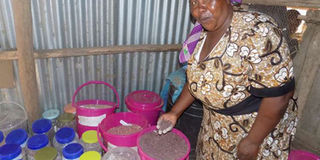We grow, treat and save our seeds for bumper harvest

A member of Nagum seed savers inside a cereals seed bank. PHOTO | RACHEL KIBUI | NATION MEDIA GROUP
What you need to know:
- On this day, the Gilgil-based women had met at Anastasia Njeri’s home in Nagum village on the slopes of Eburu hills to discuss the seeds they had stored last year for this planting season.
- The women kept the seeds, mainly beans and peas, in plastic containers in a granary to ensure that they do not consume them at home, especially when food shortage bites.
- Daniel Wanjama, Seeds Savers Network director, says most small farmers are tempted to consume their seeds or for those who store, some of them end up being destroyed by pests.
The 16 women sit at a table talking animatedly as they gesture and laugh.
Looking at them, one may dismiss the group as any other ‘merry-go-round’, where gossip reigns. But theirs is not an ordinary ‘merry-go-round’. The women, who farm, meet regularly to discuss various aspects of their businesses.
On this day, the Gilgil-based women had met at Anastasia Njeri’s home in Nagum village on the slopes of Eburu hills to discuss the seeds they had stored last year for this planting season.
The women kept the seeds, mainly beans and peas, in plastic containers in a granary to ensure that they do not consume them at home, especially when food shortage bites.
The farmers do not have access to an agrovet as the nearest is over 20km away. “There is only one agrovet at the market centre. Getting seeds there is a difficult task, the reason why we have to save ours,” says Beatrice Wairimu, a member of the Nagum Water Jug Women Group.
They started the seed-saving project about two years ago. “I have saved a total of 11kg of different types of beans and peas,” says Beatrice, the oldest member of the group aged about 85, with the youngest being 28.
Members have learnt how to identify the good seeds from their crops and harvest.
“Those crops that shoot and flower early produce the best seeds,” says Anastasia.
After identifying them, they tie a nylon strip around the stem.
The seed-producing plants are harvested separately from the other crops.
“After drying the harvested cereals, we normally gather here to sort the best grains from the weak ones.” The cereals are, thereafter, preserved with Diatomaceous dust, a pesticide and an agent that absorbs moisture to keep them dry.
At the beginning of every planting season, each member collects her seeds for planting.
“We also get a chance to exchange the seeds amongst ourselves to diversify the cereals each one of us grows.”
Nagum members are among 400 farmers who have been trained by Seeds Savers Network, a local NGO, on how to save quality seeds for planting season.
Besides cereals, they also bank sweet potato vines, arrowroots and cassavas. These are planted at a garden belonging to one of the group members and each of them can access seeds at no charge.
“We dream of having more members, saving more seeds and even having metal silos to preserve our produce.”
Daniel Wanjama, Seeds Savers Network director, says most small farmers are tempted to consume their seeds or for those who store, some of them end up being destroyed by pests.
“One of the rules we have is that a member cannot withdraw her deposit from the bank for consumption. They must wait until planting season.”
Wanjama says the good thing with the group is that members get seeds that do best in their regions.
“If they buy from the market for example, they may access seeds meant for highlands while they farm in lowlands,” he says, adding that members have been able to conserve quality indigenous seeds that are slowly becoming extinct with hybrid becoming more popular.
Simon Mathu, a Ministry of Agriculture official based in Gilgil, says the Diatomaceous dust is not only cheaper, safer, but also more effective than other pesticides.
“It is a moisture absorbent and helps in keeping cereals dry thus, less vulnerable to pests such as weevils,” says Mathu.
According to him, farmers can save up to 10 times what they would spend buying seeds, if they learn how to preserve quality ones on their farms.
“While hybrid seeds produce more, they are not necessarily accessible to all farmers. But those who can mark and select quality seeds from their own farms can easily maintain or even increase their harvests.”
He notes that some vegetative seeds like arrowroots and sweet potato vines are barely found in seed shops yet there is increased demand, thus saving helps.





